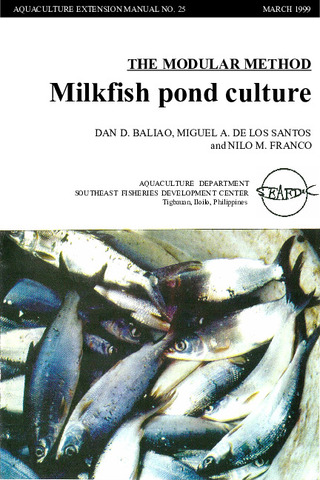Development of larval diets for milkfish (Chanos chanos)
- Global styles
- MLA
- Vancouver
- Elsevier - Harvard
- APA
- Help

View/
Date
2000Page views
2,105ASFA keyword
AGROVOC keyword
Taxonomic term
Metadata
Show full item record
Share
Abstract
This study aimed to develop nutritionally balanced and costeffective processed diets for milkfish larvae (Chanos chanos). Two larval diets (feed A and feed B) were formulated and prepared to contain 45% protein and 10% lipid. Several larval diet preparations were tried such as microbound/unpelleted (freeze-dried), microbound /pelleted (oven-dried) and microbound/flaked (drum-dried) and assessed in terms of feed particle size and buoyancy, water stability and feed acceptability. The preparation that gave the best particle size and buoyancy as well as good water stability was prepared as the microbound diet (using K-carrageenan as a binder) and flaked using a drum drier. A series of feeding experiments were conducted to determine the growth and survival of milkfish larvae reared on various feeding schemes using these processed larval diets which were fed either solely or in combination with live feed. Larvae in control treatments were reared on live foods such as Brachionus plicatilis and Artemia nauplii. Larvae were observed to ingest the diets, indicating that the feeds had suitable physical characteristics and were attractive to the larvae. The overall results of the feeding trials showed that the artificial diets could be fed to milkfish larvae in combination with Brachionus rotifers starting on day 2 or day 8, and could be fed alone starting from day 15. These promising results would reduce the dependence of milkfish larvae on live feed and would have significant economic benefits in the form of simplified milkfish hatchery procedures.
Suggested Citation
Borlongan, I. G., Marte, C. L., & Nocillado, J. N. (2000). Development of larval diets for milkfish (Chanos chanos). Journal of Applied Ichthyology , 16(2), 68-72. https://doi.org/10.1046/j.1439-0426.2000.00152.x
Type
ArticleISSN
0175-8659Collections
- Journal Articles [1258]
Related items
Showing items related by title, author, creator and subject.
-
Series: Aquaculture extension manual; No. 25
The modular method: Milkfish pond culture
Baliao, Dan D.; de los Santos, Miguel A.; Franco, Nilo M. (Aquaculture Department, Southeast Asian Fisheries Development Center, 1999)The modular method of milkfish culture (Chanos chanos) described in the manual is an improvement over the traditional extensive method. The manual is intended for the use of fish farmers and aquaculturists, extensionists, ... -
Evaluation of organic and inorganic fertilizers in brackishwater milkfish ponds
Bombeo-Tuburan, Isidra; Agbayani, Renato F.; Subosa, Precilla F. (Elsevier, 1989)The study was conducted in twelve 144-m2 ponds to evaluate the effect of different organic and inorganic fertilizers on the growth, survival, gross production, and profitability of marketable milkfish. The ... -
Milkfish breeding and hatchery technology at SEAFDEC/AQD
Unknown author (Aquaculture Department, Southeast Asian Fisheries Development Center, 1999)Describes the techniques already adopted by the private sector: broodstock management, broodstock diet, commercial fry production, live transport, and larval diet. A list of AQD research publications on milkfish is included.





